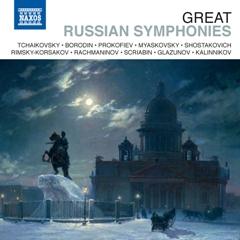Great Russian Symphonies, Vol. 4 (2012)
Great Russian Symphonies, Vol. 4 (2012)

Sergey Prokofiev - Symphony No. 5 in B flat major, Op. 100 1.I. Andante 14:05 2.II. Allegro marcato 8:58 3.III. Adagio 13:30 4.IV. Allegro giocoso 10:31 Nikolay Myaskovsky - Symphony No. 24 in F minor, Op. 63 5.I. Allegro deciso 12:38 6.II. Molto sostenuto 11:04 7.III. Allegro appassionato 11:14 Ukraine National Symphony Orchestra (1-4) Theodore Kuchar - conductor Moscow Philharmonic Orchestra (5-7) Dmitry Yablonsky - conductor
Prokofiev composed this music in 1944, and conducted its premiere in Moscow on January 13, 1945. Everyone everywhere assumed that it symbolized "world-war agony and triumph" -- in other words, his counterpart of Dmitry Shostakovich's 1941 "Leningrad" Symphony. It was the composer's Sixth Symphony of 1945-1947, not his Fifth, that recollected the horrors of World War II. Those who insisted the Fifth Symphony was a mirror of wartime agonies didn't know that the scherzo movement was borrowed from Cinderella. Nor did Prokofiev help matters by issuing one of those "position papers" expected by Soviet officialdom: "I conceived [the Fifth] as a symphony of the greatness of the human spirit."
After the failure of his Fourth Symphony (a 1929 reworking of material from his then-recent ballet, The Prodigal Son), Prokofiev turned his back on the form. When finally he did return, his implicit model was Shostakovich's Fifth of 1937 -- four movements in concerto-grosso sequence: slow, fast, slow, fast. Otherwise, though, the music is pure Prokofiev both in substance and in style.
The inaugural Andante is a sonata-form movement that begins in 3/4 time with a fluid main theme played in octave unison by flutes and bassoon, with a tailpiece in triplets that later assumes a separate identity. A lot of working-over leads to a new tune in 4/4, introduced by flute and oboe. A jittery figure in the high and low strings acquires thematic status in the development that follows directly. Brass announce the reprise by playing the opening theme very dramatically. Rhetoric accumulates, culminating in a -- why not? -- "greatness of the human spirit" coda.
The Allegro marcato scherzo (in all but name) has a D minor, Danse macabre-ish song section, followed by a slightly faster, D major trio in waltz-time, borrowed from Cinderella without blinking (or acknowledgment).
The official slow movement is a passionately lyrical, ABA Adagio in F major that begins with a reminder of Aleksandr Nyevsky (1939), but continues in the mode of Prokofiev's Romeo and Juliet ballet. He changes keys frequently to intensify expression until the climax recalls Nyevsky's battle music. A slow introduction (lightly scored, based on music from the first movement) sets up this Allegro giocoso finale in B flat major. The strings begin a rhythm in bar 23 that prepares for merriment with a sweet-sour sauce. The clarinet plays a syncopated main theme recalling the high-spirits in Romeo and Juliet, prior to the deaths of Mercutio and Tybalt; this returns throughout a rondo-like movement. Prokofiev's finale amounts to a retrospective of his stylistic direction following Symphony No. 4 -- including a return to the U.S.S.R. in 1933 -- and ends with a tour-de-force coda.
The first performance was a triumph, the climax of Prokofiev's Soviet years, followed shortly after by a physical tragedy from which he never fully recovered. Dizzied by undiagnosed hypertension, he fell downstairs (where remains moot), causing a massive concussion. ---Roger Dettmer, allmusic.com
Myaskovsky's symphonies generally have not "travelled well" outside the former Soviet Union. While he is highly regarded as a symphonist and as an artist who operated on a high esthetic plane, his dark romantic melodies, while immediately appealing to Russians, have taken longer to reach the West. In general, his many symphonies avoid the degree of drama and tragedy that Shostakovich, for instance, brings to the form.
This 35-minute-long symphony was written in 1943 and has traditionally been seen as a war symphony. (Myaskovsky was a career military officer even when he was a conservatory music student and as such had served at the front during World War I.) The two main themes of the first movement (Allegro deciso) both have elements of military fanfares, the first pronounced by the solo horn, the second, more ominous one by massed trumpets and trombones. The movement gains its dramatic effect by contrasting lyrical (but energetic) passages with powerful and decisive symphonic action.
The dramatic heart of the symphony is the second movement (Molto sostenuto). The mood is both tragic and spiritual. A Russian program annotator (Aleksei Ikonnikov) wrote that the spirtuality of the piece is not reminiscent of the icons of a monastery, but of the legendary warriors (bogatyrs) of medieval Russia going to the defense of the fatherland in a time of severe danger.
The finale (Allegro appassionato) is full of energy and conflict. Thunderous fanfares recalling the first movement constitute the main theme. Myaskovsky brings it to a confident but serious conclusion, providing the emotional summing up not only of the last movement, but of the preceding movements as well. As Ikonnov wrote, this symphony is a strong and moving memorial to the war years. ---Joseph Stevenson, allmusic.com
download (mp3 @320 kbs):
yandex mediafire uloz.to cloud.mail.ru gett
